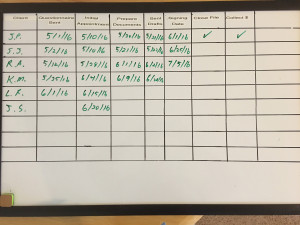Over the years I’ve had a number of conversations with attorneys about how they track their clients. Most of them feel that having a software package like Clio, Time Matters, or Amicus would help solve the problem. Up until the past few months I would have agreed that a client management software is the best way to handle tracking a client’s work.
Until I had a conversation with Jeff. He is an attorney I’ve known for over 7 years. I was talking to him back in January about how he tracks the work for his clients. He said that he has a board in his office that he uses. He has looked at other ways to do it but none have worked as well.
Then a couple of months ago I got the opportunity to take a tour of one of the Nationwide Insurance IT departments. The department that I visited spends about $500 million a year. A company that has that much money to spend would most certainly be using a sophisticated tracking software that is far superior to what Clio and other client management software can do, right?
Nope, they are using visual management for all of the tracking that is done.
I still believe in client management software. Beyond tracking what needs to be done it provides a superior way to handle other necessary tasks. But when it comes to tracking tasks for clients, I now believe that there is a better way to handle it. As they say, the proof is in the pudding.
Since that time our company has implemented our own Visual Management System and I have had a chance to help one of our clients implement it in his office. I called him up a few weeks after I helped him implement it. He told me that it has helped him better understand what needs to be done next, his desk has stayed cleaner, and he has been able to bring in more clients because he is more organized.
So how do you start?
Here is a picture of Visual Management System that I created to show you what I mean. On it you can see what is done and what the next step is. Everyone one else can also see what needs to be done.

The key to having a successful Visual Management System is to have a process in place that ensures it is updated as tasks are completed. If you would like to talk about the needs in your office, please call us at 801-766-3183.

